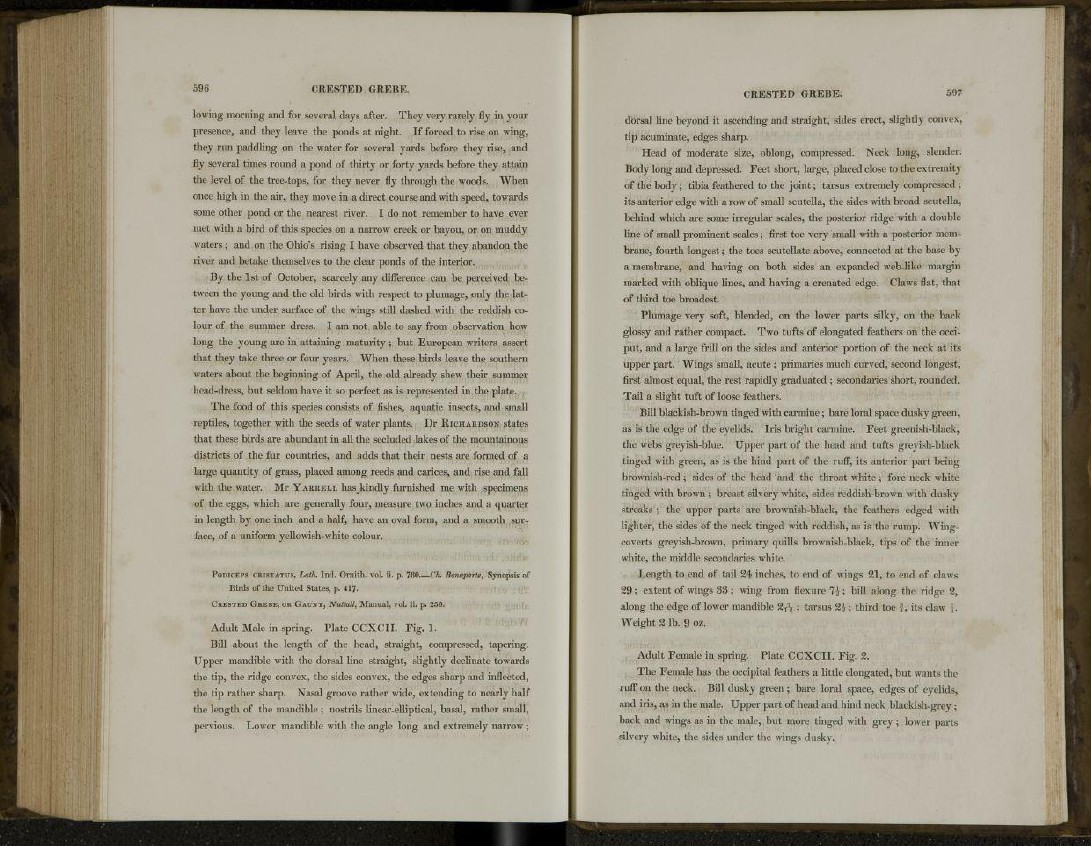
596 CRESTED GREBE.
lowing morning and for several days after. They very rarely fly in your
presence, and they leave the ponds at night. If forced to rise on wing,
they run paddling on the water for several yards before they rise, and
fly several times round a pond of thirty or forty yards before they attain
the level of the tree-tops, for they never fly through the woods. When
once high in the air, they move in a direct course and with speed, towards
some other pond or the nearest river. I do not remember to have ever
met with a bird of this species on a narrow creek or bayou, or on muddy
waters; and on the Ohio's rising I have observed that they abandon the
river and betake themselves to the clear ponds of the interior.
By the 1st of October, scarcely any difference can be perceived between
the young and the old birds with respect to plumage, only the latter
have the under surface of the wings still dashed with the reddish colour
of the summer dress. I am not able to say from observation how
long the young are in attaining maturity; but European writers assert
that they take three or four years. When these birds leave the southern
waters about the beginning of April, the old already shew their summer
head-dress, but seldom have it so perfect as is represented in the plate.
The food of this species consists of fishes, aquatic insects, and small
reptiles, together with the seeds of water plants. Dr RICHARDSON states
that these birds are abundant in all the secluded lakes of the mountainous
districts of the fur countries, and adds that their nests are formed of a
large quantity of grass, placed among reeds and carices, and rise and fall
with the water. Mr YARRELL hasjkindly furnished me with specimens
of the eggs, which are generally four, measure two inches and a quarter
in length by one inch and a half, have an oval form, and a smooth surface,
of a uniform yellowish-white colour.
PODICEPS CRISTATUS, Lath. lnd. Ornith. vol. ii. p. 780.—Ch. Bonaparte, Synopsis of
Birds of the United States, p. 4 1 7 -
CRESTED GREHE, OR GAUNT, Nuttatt, Manual, vol. ii. p. 2 5 0 .
Adult Male in spring. Plate CCXCII. Fig. 1.
Bill about the length of the head, straight, compressed, tapering.
Upper mandible with the dorsal line straight, slightly decimate towards
the tip, the ridge convex, the sides convex, the edges sharp and inflected,
the tip rather sharp. Nasal groove rather wide, extending to nearly half
the length of the mandible ; nostrils linear-elliptical, basal, rather small,
pervious. Lower mandible with the angle long and extremely narrow;
CRESTED GREBE. 597
dorsal line beyond it ascending and straight, sides erect, slightly convex,
tip acuminate, edges sharp.
Head of moderate size, oblong, compressed. Neck long, slender.
Body long and depressed. Feet short, large, placed close to the extremity
of the body; tibia feathered to the joint; tarsus extremely compressed ;
its anterior edge with a row of small scutella, the sides with broad scutella,
behind which are some irregular scales, the posterior ridge with a double
line of small prominent scales; first toe very small with a posterior membrane,
fourth longest; the toes scutellate above, connected at the base by
a membrane, and having on both sides an expanded web-like margin
marked with oblique lines, and having a crenated edge. Claws flat, that
of third toe broadest.
Plumage very soft, blended, on the lower parts silky, on the back
glossy and rather compact. Two tufts of elongated feathers on the occiput,
and a large frill on the sides and anterior portion of the neck at its
upper part. Wings small, acute ; primaries much curved, second longest,
first almost equal, the rest rapidly graduated ; secondaries short, rounded.
Tail a slight tuft of loose feathers.
Bill blackish-brown tinged with carmine; bare loral space dusky green,
as is the edge of the eyelids. Iris bright carmine. Feet greenish-black,
the webs greyish-blue. Upper part of the head and tufts greyish-black
tinged with green, as is the hind part of the ruff, its anterior part being
brownish-red ; sides of the head and the throat white ; fore neck white
tinged with brown ; breast silvery white, sides reddish-browm with dusky
streaks ; the upper parts are brownish-black, the feathers edged with
lighter, the sides of the neck tinged with reddish, as is the rump. Wingcoverts
greyish-brown, primary quills brownish-black, tips of the inner
white, the middle secondaries white.
Length to end of tail 24 inches, to end of wings 21, to end of claws
29; extent of wings 33 ; wing from flexure 7 | ; bill along the ridge 2,
along the edge of lower mandible 2 ^ ; tarsus 2 | ; third toe f, its claw .
Weight 2 lb. 9 oz.
Adult Female in spring. Plate CCXCII. Fig. 2.
The Female has the occipital feathers a little elongated, but wants the
ruff on the neck. Bill dusky green ; bare loral space, edges of eyelids,
and iris, as in the male. Upper part of head and hind neck blackish-grey;
back and wings as in the male, but more tinged with grey ; lower parts
silvery white, the sides under the wings dusky.